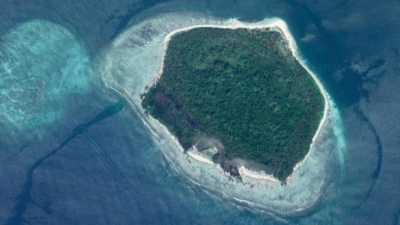On June 11, 2025, the Daily Maverick, a South African newspaper published an article that may have been about white rhinos—but what it actually revealed was something far more toxic: the persistence of colonial stereotypes in 21st-century journalism. It was a deeply offensive, condescending, and blatantly white-supremacist piece of propaganda disguised as journalism. The article, authored by Ed Stoddard and headlined Loaded for Bear: African Parks has disgracefully sent more SA rhinos to repressive Rwanda, is not just a misguided critique of conservation practices—it is a full-blown exercise in white-saviorist moral grandstanding masquerading as a defense of human rights. It stinks of racialized contempt. The piece doesn’t merely cross the line into racist discourse. It paints that line with the blood-red brush of supremacist nostalgia. And if the editors at the Daily Maverick didn’t notice, it’s not because they’re unaware—it’s because they’re complicit. Let’s start at the headline. “Loaded for Bear”? A hypermasculine, frontier-style metaphor from colonial hunting lore, brimming with implicit violence and arrogance. The irony is that the title makes no mention of white rhinos, though every part of the piece is screaming white anxiety. This is a story about white rhinos—but given the racial tone that follows, it’s hard to ignore the symbolic displacement. When white supremacy cloaks itself in environmentalism, words begin to carry disturbing dual meanings. “Much of Africa’s wildlife lies within the borders of states with questionable governance or human rights records. But some lines can be drawn in the sand. The Kigali regime stands out for the sheer scale of its repression and the regional instability it has unleashed.” Thus begins Stoddard’s article. One sentence in, and we’re already neck-deep in colonial generalization. This isn’t journalism; it’s a Manifest Destiny for environmentalists, cloaked in a khaki vest and wielding a laptop instead of a rifle. From that moment onward, the article ceases to be about wildlife and reveals itself as a thinly veiled racial tirade. The idea that African nations, particularly Rwanda, must pass the moral tests of Western journalists before being allowed to receive animals for conservation is not new—it is rooted in centuries-old racist paternalism. What follows is an unrelenting torrent of arrogance, bigotry, and pseudo-analysis. Rwanda is described as “a sinister state,” accused of “killing dissidents,” and run by “the autocratic rule of Paul Kagame.” No credible sources. No dissenting voices. Just Stoddard and his one-woman echo chamber, Michela Wrong—whose own record reeks of neocolonial disdain for African agency. Indeed, this piece is not journalism. It is supremacist bravado embedded in a platform that should know better. Stoddard relies on no credible sources for his accusations. Instead, he invokes Michela Wrong, another aging figure in the tired genre of “white journalists explaining Africa to itself.” Her book Do Not Disturb is offered as though it were the definitive moral dissection of an entire nation, with its cover and hyperlink prominently featured as if it were scripture. It is not accidental that Stoddard invokes Wrong’s propaganda machine, advertising her 2021 screed Do Not Disturb as a “clinical dissection” of Rwanda’s “pariah regime.” A book so thoroughly discredited by scholars and diplomats alike that quoting it borders on malpractice. The civilized face of modern barbarism But let us pause and consider the very tactics used in this piece. Daily Maverick editorially hyperlinked a prior article titled “Rwanda’s rhinos are safer than its dissidents”—a smug, repulsive smear that downplays a country’s post-genocide recovery while implying that conservation in Rwanda is more sinister than poaching in South Africa. Satire? No. Just supremacist sensationalism that reduces both people and animals into pawns in a game of moral one-upmanship. In this absurd theatre of moral superiority, the idea that white rhinos are safer than human beings, is outlandish. But it isn’t even original. It harks back to a centuries-old white supremacist logic—the idea that Black bodies are more expendable than white animals. Stoddard writes: “That observation still holds and, if anything, Rwanda under the autocratic rule of Paul Kagame has become even more of a pariah state with its documented support for the M23 rebels in neighbouring DRC.” “Documented support” by whom? Stoddard never names independent, verifiable sources. Instead, he just refers back to his earlier opinion piece—as if self-reference and repetition substitute evidence. He then inserts this: “African Parks sees no issue with shaking hands with the devil if it advances its conservation agenda – which is disturbing.” In case readers missed the allusion, Daily Maverick reinforces the hate message with a photo of President Kagame ‘at a press conference after his meeting with his Latvian counterpart’—alongside this “devil” metaphor. Let’s unpack this. For Stoddard, the “devil,” is Paul Kagame—Rwanda’s president. The metaphor “shaking hands with the devil” is a calculated insult. But even more insidious is its origin: the title of Roméo Dallaire’s book Shake Hands with the Devil (2003), describing his experience negotiating with genocidaires in 1994. To equate Kagame’s government—responsible for stopping the Genocide Against the Tutsi—with that of the genocidaires who orchestrated it, is not merely irresponsible. It is perverse. And what’s the purpose of that metaphor in a story about rhinos? To prime the reader for revulsion. It’s a psy-op masquerading as prose. It is crucial here to expose what is truly at play: the Western supremacist desire to manage human conscience, as if they alone possess the moral compass for global governance. This journalistic positioning, under the pretense of defending “human rights,” is actually about policing African self-determination. His article is an appeal not to protect rhinos, but to protect the white supremacist narrative: that only certain Africans deserve legitimacy, and only under conditions approved by the former empire’s descendants. It’s also important to examine the weaponization of conservation—a form of “conservation colonialism.” Western commentators, institutions, and NGOs often use wildlife issues as moral leverage to shame African states. This is part of a broader phenomenon wherein national parks in Africa are regarded as international moral property, and African governments as temporary custodians whose legitimacy must be reviewed by the Western press. This is particularly evident when Stoddard writes: “Rwanda, by the way, is not a former white rhino range state.” That is technically correct but logically hollow. South Africa was not a former liberation state either when it received exiled revolutionaries, nor was it a sanctuary of press freedom under apartheid. Yet Stoddard sees no problem there. In one of the most revealing acts of visual propaganda, the article features a photo allegedly showing M23 soldiers “on patrol in Bukavu, South Kivu, Democratic Republic of Congo, on 22 February 2025.” This image—completely unrelated to rhinos—was not an editorial oversight. It was a propaganda insertion, designed to provoke a sinister linkage between Rwanda, war in the DR Congo, and wildlife. It plays into geopolitics, particularly considering that M23—a relatively disciplined force, has repeatedly embarrassed FARDC and its allies, including South African forces in North Kivu. What we witness here is not mere bias—it is psychological projection. For Ed Stoddard and editors of Daily Maverick, African states can never “win” unless that win is approved, narrated, and moralized by their worldview. When Stoddard claims: “Mountain gorillas, for example, are only found in Rwanda and neighbouring Uganda and the DRC, and so conservation efforts for this species need to be focused in those countries, regardless of the governments in power.” He reveals a quiet admission that Rwanda, like its neighbors, is essential. Yet that admission is couched in a backhanded compliment meant to make sure Rwandan legitimacy is always provisional—subject to external review. The entire piece reeks of what we call the Enlightened against the one who is not dichotomy. For Stoddard, South Africa can birth rhinos and govern their transfer. Rwanda can only host them if it behaves well. But history has its own truths. The rhinos born in South Africa—though not white in color—are part of a lineage whose ancestors survived a regime that armed the genocidaires in Rwanda before 1994. What moral high ground does a journalist who may have worked for apartheid South Africa have when attacking Rwanda—a nation that emerged from one of the worst genocides in human history and, without handouts, has built itself up? Stoddard complains: “And let’s face it, the ruling Frelimo party [in Mozambique] has followed other African liberation movements down the well-trodden path of corruption and misrule.” Says who? A journalist who never fought for anything but deadlines and bylines? Since when did he become a philosopher of African governance? Does he speak for the people of Mozambique? Does he understand liberation struggles? This pattern reveals the supremacist double standard at work. When animals are translocated to countries with European ties or white settler minorities, there’s no editorial angst. When they’re sent to black-led nations that have asserted sovereignty, suddenly the story changes—from conservation to condemnation. Stoddard goes on to write: “The Kigali government stands out for the sheer scale of its repression and the regional instability it has unleashed. And Kagame has an instinctive understanding of what is important to the West. The rhino project comes with the prestige he craves, adding another layer of legitimacy to his regime – which does keep the streets of Kigali clean.” Just imagine a legitimacy brought to Rwanda by 70 rhinos from South Africa. What an insult to a country! This paragraph is an exercise in arrogance. It implies that the only reason Rwanda has succeeded in cleanliness, conservation, infrastructure, or global respect is because Kagame seeks to impress Westerners. What an insult to Rwandans, who wake up each last Saturday of the month for Umuganda—not because of the West, but because of their shared purpose and history. Even here—where he begrudgingly acknowledges cleanliness—it is not a virtue, but a sinister tactic. This is the colonial paranoia about “native mimicry”: the fear that the African might adopt the appearance of modernity, order, civilization—without Western permission. The truth is simpler. Rwanda’s development is not for the West. It is for Rwandans. It is the product of national will, good governance, and hard-earned transformation. Clean streets are not vanity; they are a necessity for our health and dignity. Here, again, we see the enduring 1810 worldview: cleanliness, order, discipline—these are not African traits unless supervised by the white conscience. Left alone, according to this worldview, Africans would descend into “idleness, revenge, nastiness.” Stoddard’s lens is not unique. He is simply a symptom. The editors who approved his article are the problem too. Daily Maverick, sometimes styles itself as a progressive outlet, but in publishing such vitriol, it has failed to perform even the most basic editorial scrutiny. Its platform has become a vehicle for racialized geopolitics masquerading as human rights commentary. To fully understand the intellectual scaffolding behind Ed Stoddard’s diatribe, one must reckon with the intellectual debris of Europe’s racialized history — the fossilized but still functioning stereotypes that have crossed centuries and taken on new forms. As Achille Mbembe reminds us in On the Postcolony, Africa in the Western imagination is not just a geographic place, but a “phantasmagoria” — an abstract theatre of dysfunction and need, awaiting Western redemption. This is the role Stoddard implicitly assigns himself: the redeemer, the moral steward, the white conscience-bearing chronicler of Africa’s supposed political decay. And as Edward Said wrote in Orientalism, the colonizer’s gaze does not only describe — it defines. Stoddard’s journalism is not an act of description; it is a claim to dominion, one that decides who is savage and who is civilized, who deserves rhinos and who does not. Frantz Fanon, in Black Skin, White Masks, observed the phenomenon of the white man acting not only as colonizer but as “judge, jury, doctor, and therapist of the Black soul.” This is precisely Stoddard’s posture. In his eyes, Rwanda is not a nation of sovereign actors but a political patient to be diagnosed and dismissed. And here, Chinua Achebe’s critique of Joseph Conrad’s Heart of Darkness resonates loudly. In his seminal essay ‘An Image of Africa,’ Achebe exposes how Conrad’s Africa is not a place, but a foil—a metaphorical “other world” that exists to illuminate the supposed moral journey of the European. As Achebe notes, the Africans in Heart of Darkness are denied language, agency, and humanity, reduced to “limbs and rolling eyes.” This is the narrative tradition Ed Stoddard draws upon: Africa not as a continent of thinking, planning, evolving societies, but as a moral jungle where the Western journalist navigates to save the animals—and, allegedly, the people. Which brings us back to the 1810 Encyclopaedia Britannica and its appalling entry on “The Negro” — a descriptor Stoddard would never openly cite but appears to have internalized by cultural inheritance. It reads: “Vices the most unhappy race … idleness, treachery, revenge, cruelty, impudence, stealing, lying, profanity, debauchery, nastiness and intemperance, are said to have extinguished the principles of natural law, and to have silenced the reproofs of conscience. They are strangers to every sentiment of compassion and are an awful example of the corruption of man left to himself.” This shocking description, quoted by Charles Husband’s In Black and White: The Roots of Racism in Race in Britain (1982), was not merely pseudoscience academic. It was deployed to justify the brutal systems of slavery, colonial conquest, and racial subjugation. As repulsive as it may seem today, one must not underestimate how deeply such thinking endures in the subconscious of Western commentators like Stoddard and his ilk. Their tone, sense of entitlement to dictate what constitutes good governance in Africa, and their dogged opposition to African agency in managing both wildlife and their nations are not incidental—they are ideological descendants of that very stereotype. Up till now, remnants of its sentiment persist in journalism— that positions African governance as an inherent defect and African success as an anomaly that requires foreign explanation or suspicion. It is this mentality—dressed now in the “rational” language of conservation and human rights—that Stoddard embodies. The last safari of supremacism What we witnessed in Ed Stoddard’s article is not journalism—it’s the ghost of colonial arrogance on safari, clutching a notepad instead of a rifle, lamenting that the natives are no longer grateful. He wishes he could decide where the rhinos go, where Africans govern, and how history should be remembered. And when he can’t, he rants. When Africa shows agency, he responds with alarm. When Africans succeed, he demands to know which Western donor to thank. This is not a concern for human rights. This is aesthetic panic: how dare Africans be clean, orderly, successful—without permission? The white rhinos are just a prop. The real beast being hunted is African dignity. And Stoddard, standing atop his ivory journalistic perch, wishes to shoot it down with words soaked in inherited supremacy. The Daily Maverick has allowed itself to become a platform for neocolonial projection. It has enabled a writer who uses wildlife as a Trojan Horse to reintroduce 19th-century racism through 21st-century journalism. Because Stoddard’s concern is not human rights. It is ideological compliance. Governments that defy Western paternalism are labeled “pariahs.” Those that bow are forgiven their sins. Stoddard’s article is not a critique of conservation policy. It is a manifesto of white supremacist sentiment disguised as environmental concern. It is a declaration that Africans can be tolerated only when they are chaotic, corrupt, or pitiable—but never when they are efficient, independent, or successful. For the record: Rwanda is not perfect. No nation is. But its people have chosen transformation over trauma, dignity over dependency. That a nation which survived a genocide now hosts rhinos, gorillas, and clean urban streets and in rural areas, is not a threat. It is a triumph. And that—more than any NGO or president—is what truly enrages Stoddard and his ilk. The sight of an African country refusing to conform to their low expectations is the greatest threat of all. But no matter how loudly he bellows, Rwanda will not crawl. Africans will not beg. And rhinos will not seek colonial passports. The days of managing Africa’s conscience from far away desks are over. This is no longer Out of Africa — it’s out of touch. And the mask of moral superiority? It has finally cracked. They want Africa wounded. Rwanda insists on healing. They want Africans to beg. Rwanda insists on building. They want Africans in the jungle. Rwanda offers gardens. And so, they howl. Let them. The white rhinos are at home in Akagera National Park. And the real beasts have revealed themselves—in the pages of Daily Maverick. And so, to Ed Stoddard and his kind, here’s the hard truth: We do not need your permission to build our future. Rwanda is not your exhibit. Kigali is not your zoo. Our governance is not subject to your conscience. Your metaphors are exhausted. Your racism is noted. And your failure to evolve is your own burden to carry.
Provided by SyndiGate Media Inc. (
Syndigate.info
).










